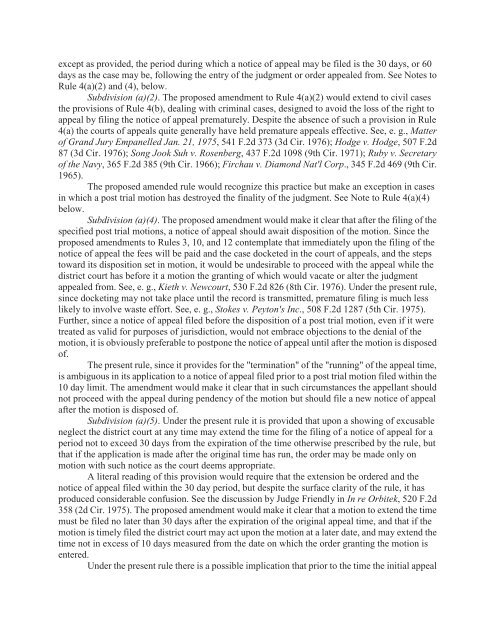Federal Rules of Appellate Procedure 2014-2015, 2014a
Federal Rules of Appellate Procedure 2014-2015, 2014a
Federal Rules of Appellate Procedure 2014-2015, 2014a
You also want an ePaper? Increase the reach of your titles
YUMPU automatically turns print PDFs into web optimized ePapers that Google loves.
except as provided, the period during which a notice <strong>of</strong> appeal may be filed is the 30 days, or 60<br />
days as the case may be, following the entry <strong>of</strong> the judgment or order appealed from. See Notes to<br />
Rule 4(a)(2) and (4), below.<br />
Subdivision (a)(2). The proposed amendment to Rule 4(a)(2) would extend to civil cases<br />
the provisions <strong>of</strong> Rule 4(b), dealing with criminal cases, designed to avoid the loss <strong>of</strong> the right to<br />
appeal by filing the notice <strong>of</strong> appeal prematurely. Despite the absence <strong>of</strong> such a provision in Rule<br />
4(a) the courts <strong>of</strong> appeals quite generally have held premature appeals effective. See, e. g., Matter<br />
<strong>of</strong> Grand Jury Empanelled Jan. 21, 1975, 541 F.2d 373 (3d Cir. 1976); Hodge v. Hodge, 507 F.2d<br />
87 (3d Cir. 1976); Song Jook Suh v. Rosenberg, 437 F.2d 1098 (9th Cir. 1971); Ruby v. Secretary<br />
<strong>of</strong> the Navy, 365 F.2d 385 (9th Cir. 1966); Firchau v. Diamond Nat'l Corp., 345 F.2d 469 (9th Cir.<br />
1965).<br />
The proposed amended rule would recognize this practice but make an exception in cases<br />
in which a post trial motion has destroyed the finality <strong>of</strong> the judgment. See Note to Rule 4(a)(4)<br />
below.<br />
Subdivision (a)(4). The proposed amendment would make it clear that after the filing <strong>of</strong> the<br />
specified post trial motions, a notice <strong>of</strong> appeal should await disposition <strong>of</strong> the motion. Since the<br />
proposed amendments to <strong>Rules</strong> 3, 10, and 12 contemplate that immediately upon the filing <strong>of</strong> the<br />
notice <strong>of</strong> appeal the fees will be paid and the case docketed in the court <strong>of</strong> appeals, and the steps<br />
toward its disposition set in motion, it would be undesirable to proceed with the appeal while the<br />
district court has before it a motion the granting <strong>of</strong> which would vacate or alter the judgment<br />
appealed from. See, e. g., Kieth v. Newcourt, 530 F.2d 826 (8th Cir. 1976). Under the present rule,<br />
since docketing may not take place until the record is transmitted, premature filing is much less<br />
likely to involve waste effort. See, e. g., Stokes v. Peyton's Inc., 508 F.2d 1287 (5th Cir. 1975).<br />
Further, since a notice <strong>of</strong> appeal filed before the disposition <strong>of</strong> a post trial motion, even if it were<br />
treated as valid for purposes <strong>of</strong> jurisdiction, would not embrace objections to the denial <strong>of</strong> the<br />
motion, it is obviously preferable to postpone the notice <strong>of</strong> appeal until after the motion is disposed<br />
<strong>of</strong>.<br />
The present rule, since it provides for the "termination" <strong>of</strong> the "running" <strong>of</strong> the appeal time,<br />
is ambiguous in its application to a notice <strong>of</strong> appeal filed prior to a post trial motion filed within the<br />
10 day limit. The amendment would make it clear that in such circumstances the appellant should<br />
not proceed with the appeal during pendency <strong>of</strong> the motion but should file a new notice <strong>of</strong> appeal<br />
after the motion is disposed <strong>of</strong>.<br />
Subdivision (a)(5). Under the present rule it is provided that upon a showing <strong>of</strong> excusable<br />
neglect the district court at any time may extend the time for the filing <strong>of</strong> a notice <strong>of</strong> appeal for a<br />
period not to exceed 30 days from the expiration <strong>of</strong> the time otherwise prescribed by the rule, but<br />
that if the application is made after the original time has run, the order may be made only on<br />
motion with such notice as the court deems appropriate.<br />
A literal reading <strong>of</strong> this provision would require that the extension be ordered and the<br />
notice <strong>of</strong> appeal filed within the 30 day period, but despite the surface clarity <strong>of</strong> the rule, it has<br />
produced considerable confusion. See the discussion by Judge Friendly in In re Orbitek, 520 F.2d<br />
358 (2d Cir. 1975). The proposed amendment would make it clear that a motion to extend the time<br />
must be filed no later than 30 days after the expiration <strong>of</strong> the original appeal time, and that if the<br />
motion is timely filed the district court may act upon the motion at a later date, and may extend the<br />
time not in excess <strong>of</strong> 10 days measured from the date on which the order granting the motion is<br />
entered.<br />
Under the present rule there is a possible implication that prior to the time the initial appeal


















